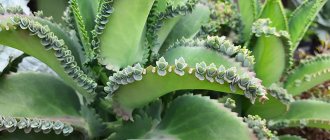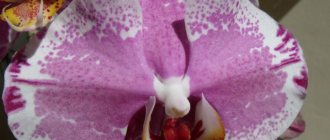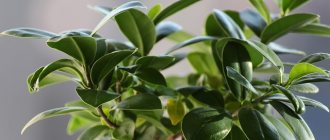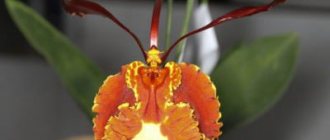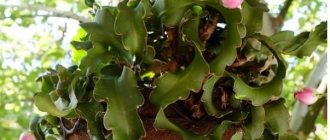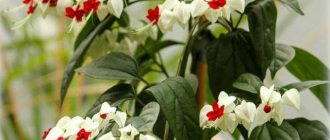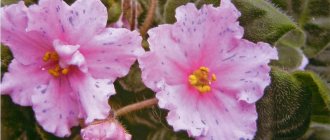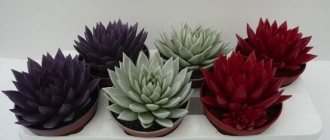There are several legends about this plant, and one of them says that long ago dragons hunted elephants and somehow, in the struggle for life, both animals died. And their blood mixed and washed the trees that were nearby, which caused a change in appearance. This is how dracaena appeared and in this article you will learn how to care for it so that the plant pleases you with its attractive appearance. In fact, everything is very simple, since this unusual palm tree is not at all whimsical.
Growing dracaena. The illustration for the article is used under the standard license ©delniesoveti.ru
Dracaena has several species that are completely different from each other. First, I will tell you a little about each species of dracaena and then you will find out what care it needs at home.
edged dracaena
Dracaena care.
The illustration for the article is used under a standard license ©delniesoveti.ru This type of dracaena is considered an evergreen plant. In appearance it is similar to a palm tree: a thick trunk and spreading, hard and long leaves with pointed edges. Dracaena marginata also has a sister, Dracaena marginalata, it differs in that it has a red border, it can be wide or narrow. In the wild, this border is narrow and purple in color.
Types of home dracaena: brief description
Having figured out how to care for the dracaena palm tree, it is worth studying the varieties of the flower and the nuances of caring for each type.
Dracaena marginata
There are two varieties of this flower: Marginata and Magenta. The only difference between them is the color of the leaf plates. Marginata has leaves with a reddish tint, while Magenta has green leaves. Caring for Dracaena Magenta is no different from caring for the second species. These narrow-leaved varieties include many varieties, differing in size, color and shape of leaves, shoots and flowers. Long leaf plates are collected at the top of the trunk. In appearance, the flower resembles a palm tree and grows very slowly. The second name of the species is Dracaena bordered.
Caring for dracaena Manginata and Marginata is not difficult, because the plant tolerates places with low light and infrequent watering. The palm grows up to three meters in height, but its dwarf varieties are usually grown at home.
Dracaena Verneski
This variety belongs to the fragrant class. The evergreen bush reaches a height of 1.2 m. The leaves are sword-shaped, hard and long with a dark green color and longitudinal light stripes on the surface.
Dracaena Sandera
This bamboo-shaped spiral variety grows up to 80 cm in height. There are many varieties with twisted stems, thin elongated leaves and light green shoots. There are variegated varieties. When flowering, the plant produces spikelets that change color from green to golden. After the flowering period the bush dies.
Dracaena bent
Despite the name, the stems of this variety are erect, but have slight tortuosity. The glossy, dark green leaves are quite narrow and rigid and are arranged in a spiral on the stem. There are variegated varieties with light stripes on the leaf blades.
Dracaena surculosa
It grows slowly and has a thin, erect or flat stem 60 cm long. Large, wide, lanceolate leaf plates of a dark green color. There are varieties with variegated leaves that have stripes and specks of contrasting shades. White flowers in inflorescences have a pleasant aroma.
Dracaena Canary
The second name is dragon tree. The bush is distinguished by a thick, powerful trunk and a rather lush crown of leaves 60 cm long. At home, the tree grows up to 1.2 m in height. The hard leaf blades are covered with a bluish waxy coating. During flowering, a peduncle with white, pleasantly smelling flowers is formed.
Dracaena Fragrant
This broad-leaved, thick-stemmed plant has one or more stems with green, glossy leaf blades. There is a yellow border or stripes along the edge of the leaves. When palm trees bloom, white, loose panicles are formed that smell pleasant, but flowers rarely appear at home. The slowly growing bush reaches a height of two meters. It purifies the indoor air.
Dracaena Derema
A multi-stemmed species with lanceolate, green, glossy leaves that reach 1.5 m in length, during flowering they are decorated with panicle-shaped inflorescences up to one and a half meters long. The flowers grow up to 25 mm in diameter and are white in color. In an adult plant, the stem diameter reaches 300 mm, and young shoots form a single unbranched stem with a leaf rosette.
Dracaena Godsefa
An evergreen large-leaved bush with erect stems reaching a height of 60 cm. The elliptical leaf blades with a pointed tip have a dark green color and whitish spots on the surface. The young leaves are rolled into a tube, and the inflorescences with fragrant white flowers grow up to 8 cm long.
Dracaena Massangeana
This variety has a powerful trunk, at the top of which there is a bunch of oblong leaves with light stripes in the center. The bush grows up to one and a half meters and reaches 40 cm in diameter. The variety feels good in partial shade and looks like a palm tree.
Dracaena Hooker
This tree-like variety grows up to 1.8 m and has sword-shaped large leaves with a glossy surface, longitudinal veins and a thin white border. The greenish-white flowers are rather inconspicuous.
Dracaena fragrant
The illustration for the article is used under a standard license ©delniesoveti.ru
Dracaena received this name due to its flowering, the flowers of which have a pleasant aroma. The fragrant dracaena reaches 2 meters, it has wide and long (about 60 cm) green leaves. Fragrant dracaena blooms only in nature; at home, flowering appears very rarely.
Dracaena diseases
Home care for Dracaena marginata or other species includes treatment and prevention of various diseases.
The leaves are turning yellow
If the lower leaves turn yellow and fall off, then this is a normal natural process that occurs every two years. But if young leaf blades turn yellow, the reason lies in non-compliance with watering rules. This usually happens due to lack of moisture. The palm tree is watered as the top layer of soil dries, but keep in mind that it should not dry out deeper than 20-30 mm from the surface.
Dracaena dries
Another sign indicating a lack of moisture is drying of the ends of the leaves. They not only dry out, but also darken. For treatment, the plant is periodically sprayed. It is especially important to do this during the warm season.
The flower dries out due to lack of nutrients in the soil. An overabundance of fertilizer causes a similar problem. A large amount of nutrients causes the roots to “burn” and the subsequent death of the bush.
Advice! If the watering rules are followed, but the leaves still dry out, the flower is transplanted into new soil.
Dracaena began to rot
Rotting of the stem is caused by a bacterial infection. Moreover, the palm tree rots from the top. Gradually, wet dark spots cover all the leaves, after which the trunk begins to rot from the inside. It is impossible to save the bush.
The palm tree is affected by bacteria due to waterlogging of the soil or due to decreased immunity due to a lack of phosphorus and potassium. Also, a bacterial infection actively develops at high temperatures or in conditions of low acidity of the substrate. If the soil is very dense and heavy, the same problem appears. To save a flower, it is replanted in suitable soil, the rules of watering and lighting are strictly followed, and the optimal temperature in the room is maintained.
Falling leaves
If the Dracaena plant loses its leaves, the problem arises for the following reasons:
- roots rot;
- the flower is frozen;
- excessive soil moisture;
- hypothermia of the earthen coma;
- infectious diseases.
Most often, leaves fall on old palm trees that are poorly cared for. For medicinal purposes, the bush is sprayed every 10 days with special solutions.
Plant pests
If a houseplant is attacked by pests, which is very rare, then it is important to take action as early as possible to protect the bush from death.
Caring for geraniums at home for beginners: propagation and replanting
Palm trees are affected by the following types of parasites:
- thrips;
- mealybug;
- aphid;
- scale insect;
- spider mite
Moreover, pests spoil not only the ground part, but also the root system, which leads to the shedding of leaves. To combat parasites, use a soap solution. To destroy spider mites, the solution is used hot. Then they are sprayed with an insecticide, and after two weeks the procedures are repeated.
Dracaena how to care
How to water dracaena
We can say that watering dracaena is considered almost the most important point in caring for dracaena at home. If you do not approach watering correctly, you can ruin your indoor plant. Any type of dracaena does not like excessive soil moisture. The exception is the tree of happiness (Dracaena Sandera), as it likes to be in water. In other dracaenas, the roots may begin to rot due to waterlogging.
How to water dracaena in winter and summer
Diseases and pests of indoor palm trees
Dracaena is often affected by fungal diseases:
Alternaria
(dry spotting)
Infected leaves and trunk tissues wither and die.
Fusarium
The fungal infection spreads from the roots. After a short time, yellowish spots appear on the leaves and the trunk dries out.
Wet rot
Watery spots can be seen on all parts of the plant. The disease is transient, dracaena dies within a few days.
Bacteriosis
The tips of the leaf blades darken and dry out, small ulcers appear on the stems, separated from healthy tissue by a light yellow stripe.
Fungal infections can only be controlled with chemical or biological fungicides.
Shchitovka
Thrips
Spider mite
Scale insects, thrips, and spider mites feed on plant juices. The process of photosynthesis is disrupted, the leaves turn yellow and fall off. The disease affects the above-ground part, then spreads to the root system. Insect pests can not only slow down growth, but also completely destroy the plant.
At an early stage, you can fight parasites using traditional methods, using a solution of laundry soap, ammonia, tobacco decoction or garlic infusion. In case of massive damage, only chemical methods will help: treatment with Fitoverm, Actellik, Fufanon, etc.
"Fitoverm"
"Aktellik"
"Fufanon"
Effective preventive measures include proper care. It is necessary to maintain optimal humidity and temperature, prevent dust accumulation, and regularly apply fertilizer.
Video
Dracaena care
A selection of videos about transplanting and caring for dracaena. About its diseases and pests, and ways to combat them.
Dracaena care at home
Where to place dracaena
As I wrote above, dracaena is an unpretentious plant. It can be placed in a bright place, or placed in the shade. However, a dracaena located in a bright room will look much brighter and its foliage will be more lush than that of a dracaena that stands in the shade.
The illustration for the article is used under the standard license ©delniesoveti.ru
Based on the above, it is better to place the dracaena in a bright room, but make sure that direct sunlight does not fall on it, as the leaves can get burned.
The more variegated the color of dracaena leaves, the more light it needs.
Where to place dracaena in the house?
When describing how to care for dracaena in a pot, it is first of all important to choose a suitable place for it. It does not tolerate direct sunlight, but needs good lighting. It is forbidden to place the pot on the windowsill of a south window. If there is no other option, then the flower is placed in a special floor stand and placed at a distance of 0.5 m from the window, protected from sunlight with a curtain. This is the only way to protect the sheet plates from burns.
The palm tree should not be placed on a north window or in a draft. The best option is to install the pot on the windowsill of an eastern or western window, but in the summer heat even here you will have to protect the leaves from direct sunlight.
Dracaena care and feeding
The plant also needs fertilizing so that it grows beautiful and healthy. Unfortunately, after a while the flowerpot becomes crowded and important substances dry out very quickly. Therefore, dracaena needs to be fed during the active period, from March to November. In winter, the plant does not need frequent feeding, since at this time the dracaena begins its dormant period, therefore, at this time, 1 feeding per month is sufficient.
And in the spring-summer period, the plant is fed once every 2 weeks. To do this, you can use any fertilizer for indoor flowers, although there are fertilizers specifically for palm trees on sale, they are called “For palm trees”
How to replant
Over time, the soil changes structure, becomes compacted, caked, and the roots do not receive enough oxygen. To avoid this, a transplant is needed. It is held in the spring. Select soil special for dracaenas or mix the soil yourself (in equal proportions - turf, leaf soil, compost and fine gravel); drainage must be placed at the bottom of the pot.
If the plant is less than three years old, replant it every year. Adults, large and slow-growing ones are replanted every couple of years. For very large plants, such as adult dracaenas, replanting is carried out in extreme cases, but the top soil is changed once a year.
You should not immediately replant a purchased plant; let it adapt a little. During the period of flowering and disease, replanting is also not recommended.
Dracaena propagation
When describing how to care for dracaena in a pot, special attention should be paid to its reproduction. Most often, new trees are grown by rooting a cut part of the trunk. In addition, propagation methods are used by cuttings, seeds and air layering.
Growing from seeds
Only evergreen varieties of dracaena have seeds. During the flowering period of the palm tree, it is artificially pollinated and seeds are obtained. First, they are kept in a growth activator for some time. Then the seeds are transferred to the soil and watered. The pallet is covered with film and placed on the windowsill. In a maximum of 2 months, the first shoots will appear. They are watered and fed. When the height of the sprout is 60 mm, it is transplanted into a separate pot.
Propagation by stem pieces
The cut piece of stem is additionally divided into several parts 1-1.5 cm long.
Growing goes like this:
- one end of the cut stem is cut directly above the bud, and this cut is placed in the ground;
- cover the pot with a jar, select a warm place with diffused light;
- periodically the mini-greenhouse is opened and the soil is moistened;
- as soon as the first shoots appear, the jar is removed;
- young leaves are sprayed with settled water.
First steps after purchasing dracaena
Often indoor flowers are sold in a temporary substrate and a small pot. It is not recommended to replant dracaena immediately after acquisition. It is placed on a separate windowsill, away from other flowers. She has been in quarantine for two weeks. It is important to provide moderate watering and the same lighting. Fertilizers are not applied to the soil.
The popular bookmaker has released a mobile application for Android, you can follow the link absolutely free.
After 14 days, conclusions can be drawn about the absence of diseases. Also during this time the bush adapts to new living conditions. Now it can be transplanted into a permanent pot or moved to a common windowsill.
